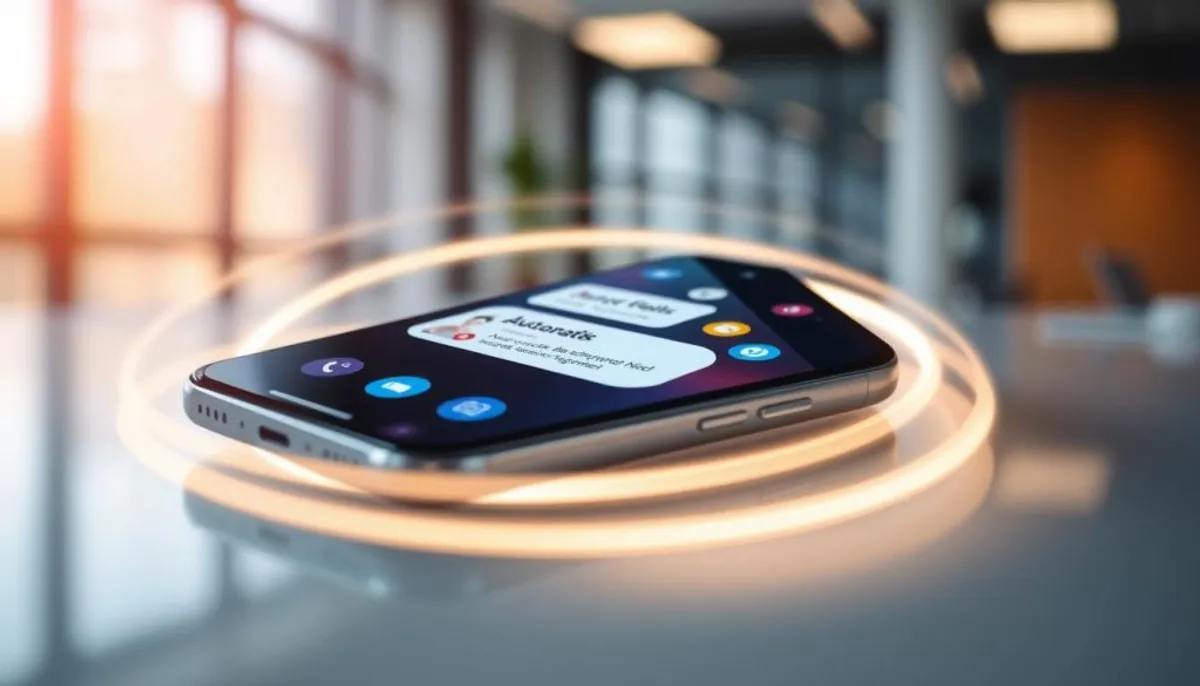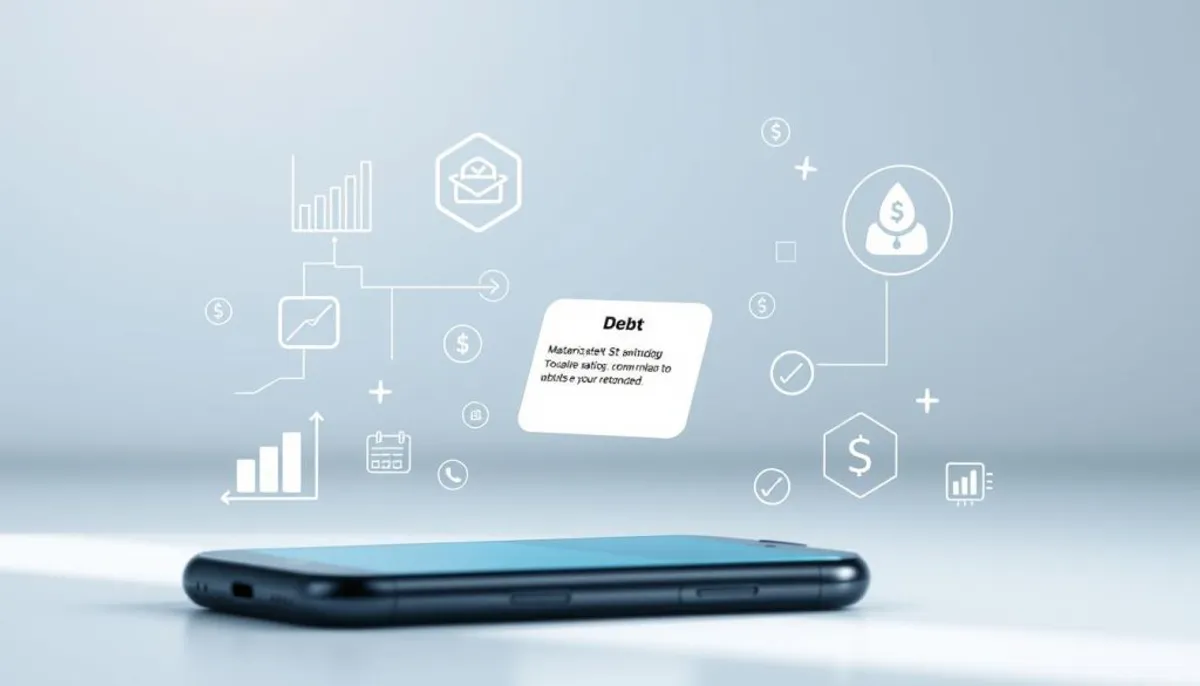The realm of debt recovery is undergoing a significant transformation. SMS debt collection is at the forefront, revolutionizing the way businesses manage overdue accounts. This innovative method leverages the omnipresence of text messages, ensuring that debtors receive notifications directly on their smartphones.
Text message debt recovery transcends mere trend status; it is a paradigm shift. With an astonishing open rate of up to 98%, SMS outshines email by a considerable margin. This disparity underscores the efficacy of SMS in ensuring that messages are not only received but also acted upon.

Automated debt reminders are a cornerstone of this evolving landscape. They not only optimize time and financial resources but also maintain a consistent flow of communication. Their simplicity in setup and management further enhances the efficiency of debt collection processes.
Effective SMS debt collection, though, extends beyond mere transmission. It involves crafting personalized messages that can significantly elevate response rates and the amount of payments received. The integration of advanced tracking systems allows for continuous evaluation and refinement of strategies, ensuring optimal outcomes.
Key Takeaways
- SMS debt collection has a 98% open rate
- Text messages are read within 3 minutes by 90% of recipients
- Automated reminders save time and improve consistency
- Personalized messages can increase payment amounts by 26%
- Digital debt collection has increased recovery rates by 65%
- 4 out of 5 customers prefer to resolve debts through digital portals
The Evolution of Digital Debt Collection
The debt collection landscape has undergone a significant transformation with the advent of digital technologies. Traditional methods are being replaced by innovative digital debt communication strategies. These new approaches focus on enhancing efficiency and customer experience.
Traditional vs Modern Collection Methods
The era of relying solely on phone calls and letters is behind us. Today, the debt recovery process incorporates mobile debt collection techniques that resonate with consumer preferences. Research indicates that most individuals now prefer live-chat, chatbots, and SMS for their debt-related interactions.
Rise of Mobile Communications in Debt Recovery
Mobile technology has transformed debt collection. SMS debt alerts provide non-intrusive, real-time communication that engages customers more effectively. This method offers flexibility and reduces stress through autonomous updates, leading to increased recovery rates.
Technology Integration in Collection Processes
Modern debt collection is deeply rooted in cutting-edge technology. AI and machine learning automate tasks and suggest optimal strategies. Data analytics inform decisions, while blockchain enhances transparency. These advancements significantly boost efficiency, reduce costs, and improve compliance in the debt recovery process.
| Traditional Methods | Modern Digital Methods |
|---|---|
| Phone calls | SMS debt alerts |
| Letters | Chatbots |
| In-person visits | Self-service portals |
| Manual tracking | AI-driven analytics |
Understanding SMS Debt Collection Fundamentals
Text-based debt management has transformed the landscape of handling outstanding payments. Short message service debt collection emerges as a cost-effective strategy, saving thousands of dollars while preserving customer goodwill. This innovative method harnesses mobile technology to enhance communication efficiency and collection outcomes.
SMS debt collection entails sending tailored text messages to debtors. These messages serve as payment reminders, provide account details, and outline debt relief options. The method’s strength resides in its immediate and accessible nature.
Let’s examine some pivotal statistics illustrating SMS’s efficacy in debt recovery:
| Metric | SMS | |
|---|---|---|
| Open Rate | 98% | 20% |
| Response Rate | 45% | 6% |
| Read within 3 minutes | 95% | 22% |
These figures underscore the growing appeal of short message service debt collection. It transcends mere reach, focusing on engagement. Personalized texts have been proven to enhance customer satisfaction by 55%, encouraging debtors to respond and act.
Adopting text-based debt management necessitates adherence to best practices:
- Employ clear, concise language
- Properly identify as a debt collector
- Offer accurate debt information
- Include straightforward payment options via URL shorteners
- Comply with legal mandates and obtain consent
By integrating SMS debt collection, companies can notably enhance their recovery rates. This approach also fosters stronger client relationships.
Legal Framework and Compliance Requirements
Ensuring debt collection compliance is paramount in today’s recovery solutions. The industry is bound by strict regulations to safeguard consumers and uphold ethical standards. The Fair Debt Collection Practices Act (FDCPA) and the Telephone Consumer Protection Act (TCPA) are pivotal in governing SMS debt collection practices.
Fair Debt Collection Practices Act (FDCPA) Guidelines
The FDCPA establishes benchmarks for debt collectors. It prohibits tactics such as harassment, making false statements, and engaging in unfair practices. Collectors must clearly identify themselves and provide accurate debt information. The act further restricts contact hours to between 8 a.m. and 9 p.m. local time.
Telephone Consumer Protection Act (TCPA) Regulations
The TCPA governs automated text messages in debt collection. It mandates obtaining prior consent from debtors before sending texts. Collectors must also promptly honor opt-out requests. Non-compliance can lead to significant fines, underscoring the importance of TCPA adherence.
Consent and Opt-out Requirements
Securing consent is a fundamental aspect of SMS debt collection. Collectors must transparently outline their text messaging usage and obtain written consent. They must also offer straightforward opt-out options in every message. Adherence to these guidelines is crucial for avoiding legal repercussions and fostering trust with debtors.
| Compliance Aspect | Impact on Collection |
|---|---|
| FDCPA Compliance | 15% increase in success rates |
| Regulation F Compliance | 20% reduction in legal disputes |
| Respecting Communication Preferences | 10% increase in successful recoveries |
ti3 Platform: Revolutionizing Debt Recovery
The ti3 platform is transforming debt recovery. It employs an automated debt reminder system, offering a novel approach to an age-old challenge. This innovation simplifies debt collection, enhancing its efficiency and effectiveness.
Automated Payment Reminder System
ti3’s automated system ensures timely reminders to debtors. This eliminates the need for continuous manual intervention, streamlining the process. It meticulously tracks due dates and dispatches notifications precisely, significantly elevating collection success rates.

Client Relationship Management Features
In the realm of debt recovery, fostering strong client relationships is paramount. ti3 excels in this area with its advanced client relationship management tools. It centralizes client data, facilitating seamless tracking of interactions and payment histories.
Cost-Effective Collection Solutions
ti3 presents a cost-efficient debt collection framework. It minimizes manual labor, thus reducing operational costs and enhancing productivity. The platform’s automation necessitates a smaller workforce, positioning ti3 as a financially prudent option for businesses aiming to optimize their collection strategies.
| Feature | Benefit |
|---|---|
| Automated Reminders | Increases on-time payments |
| Client Management | Improves customer relations |
| Cost-Effective Solutions | Reduces operational expenses |
ti3’s integration of automation, client-centricity, and cost-effectiveness is redefining debt recovery standards. It’s a pivotal tool, revolutionizing how businesses manage unpaid accounts, ensuring a more streamlined experience for all stakeholders.
Benefits of Text-Based Collection Strategies
Text message debt recovery has transformed the handling of overdue accounts for businesses. The advantages of SMS debt collection are significant, making it a favored choice for many creditors. Let’s examine the reasons behind its growing popularity in the industry.
SMS reminders provide a subtle means of communication with debtors. Unlike phone calls, which can be intrusive, text messages are less likely to surprise recipients. This subtlety results in higher engagement and quicker responses. Remarkably, 98% of text messages are read, outperforming traditional methods in effectiveness.
| Method | Read Rate | Cost-Effectiveness | Response Time |
|---|---|---|---|
| SMS | 98% | High | Fast |
| 20-30% | Medium | Moderate | |
| Physical Mail | Unknown | Low | Slow |
Automated SMS scheduling enhances effectiveness over traditional methods. It enables businesses to send timely reminders and updates without the need for lengthy conversations. This efficiency leads to cost savings, notably when dealing with large volumes of overdue accounts.
Text-based strategies also facilitate personalized communication. Debt collectors can segment late payers and craft messages tailored to their specific stage in the payment process. This targeted approach boosts the likelihood of successful debt recovery while preserving a respectful tone.
Modern Recovery Solutions Technology Stack
The debt collection industry has undergone a profound transformation, embracing digital solutions. Cloud-based debt collection systems are at the forefront of this change. They provide a comprehensive technology stack that boosts efficiency and security.
Cloud-Based Infrastructure
Cloud-based infrastructure is the cornerstone of modern debt recovery systems. It enables scalable operations and flexible access. Agencies can now manage up to 100 calls per minute, a stark contrast to human agents’ 100 calls per day. This efficiency results in a 35% decrease in call center expenses.
Security and Data Protection
Data protection is crucial in debt recovery. Modern systems employ advanced security measures to protect sensitive information. AI-powered solutions reduce human error by 87%, ensuring more precise and reliable operations. Multi-factor authentication further enhances cloud-based platform security.
Integration Capabilities
Integration capabilities are essential in modern recovery solutions. These systems integrate seamlessly with existing databases, enhancing debt collection processes. This integration boosts efficiency by 43% and debt recovery rates by 80%. The technology stack also enables real-time tracking and detailed reporting, improving operational transparency by up to 50%.
By adopting these advanced technologies, debt collection agencies can optimize their processes, ensure compliance, and significantly enhance their recovery rates.
Best Practices for SMS Debt Collection
Effective SMS debt collection necessitates a harmonious blend of timing, content, and responsiveness. Adherence to sms debt collection best practices enhances recovery rates and fosters enduring client relationships.
Message Timing and Frequency
Timing is paramount in SMS debt collection. Initiate reminders a week before the due date, then follow up a couple of days before. Send a final notice post-due date. Adhere to a 8 a.m. to 9 p.m. local time window to meet regulatory standards. Given that 90% of recipients engage with SMS within three minutes, their efficacy is undeniable.
Content Guidelines and Templates
Debt collection message guidelines underscore the importance of direct and succinct communication. Clearly state the amount owed to expedite payment. Messages should not exceed 160 characters to avoid additional costs. Employ templates for uniformity but personalize when feasible. Always include an opt-out option to adhere to legal mandates.
| Message Element | Best Practice |
|---|---|
| Length | Under 160 characters |
| Content | Include amount owed |
| Opt-out | Provide clear instructions |
| Tone | Professional and respectful |
Response Management Protocols
Establish protocols for timely debtor inquiries. Aim to respond within 90 seconds, mirroring the average SMS response time. Consider integrating SMS with phone calls to bolster debt recovery efforts. Implement a maximum retry option, allowing up to 10 resends with customizable delays.
By following these sms debt collection best practices, agencies can capitalize on SMS’s 98% open rate. This approach improves collection efficiency while ensuring compliance and customer satisfaction.
Automated Debt Reminder Systems

Automated debt reminder systems have transformed the debt collection landscape. These advanced tools send timely payment reminders autonomously, streamlining the debt recovery process. By adopting debt collection automation, businesses can minimize errors and ensure consistent communication with debtors.
The advantages of automated debt reminders are profound:
- Enhanced efficiency in debtor outreach
- Optimized timing for follow-ups
- Lower operational costs
- Improved adherence to regulatory standards
Modern automated systems seamlessly integrate with CRM platforms, offering real-time data access. This integration enables smarter scheduling and personalized communication, boosting debt recovery success rates. Advanced analytics tools track payment habits and response rates, allowing businesses to continually refine their strategies.
While automation boosts efficiency, maintaining a human touch is essential. Empathetic communication during debt collection can build positive relationships with debtors. As technology advances, companies must remain vigilant about legal and ethical standards to ensure compliance and avoid penalties.
The future of automated debt reminders hinges on AI-powered innovations. These advancements promise to enhance predictive analytics and decision-making in debt collection workflows. This will make the process more effective and customer-centric.
Digital Communication Strategies for Delinquent Accounts
In today’s digital era, effective digital debt communication is paramount for managing delinquent accounts. Modern strategies emphasize personalized engagement to boost recovery rates.
Message Personalization Techniques
Personalizing delinquent account notifications significantly enhances engagement. Research indicates that 37% of customers prefer SMS for debt-related communication. Tailoring messages to individual circumstances fosters a more empathetic and effective dialogue.
Escalation Procedures
When initial outreach fails, a structured escalation process is essential. This may involve:
- Increasing message frequency
- Switching communication channels
- Involving specialized collection teams
Timely escalation is critical, as accounts with continuous deficits for four months are at high risk of delinquency.
Payment Channel Integration
Integrating multiple payment options within digital communications simplifies the repayment process. This strategy has yielded impressive results:
- 24% increase in total payments
- 55% increase in total payment amounts
- 26% increase in average payment amounts
Offering convenient payment methods boosts collection rates and enhances customer satisfaction.
Adopting these digital strategies can revolutionize delinquent account management, leading to improved outcomes for both creditors and borrowers. With the right approach, digital communication becomes a potent tool in modern debt recovery efforts.
Measuring Collection Performance and ROI
Optimizing SMS debt recovery strategies necessitates the tracking of debt collection ROI and collection performance metrics. Companies that manage collections manually often face challenges in efficiency. They spend 30% of their time on preparation and only 20% on actual customer communication. The adoption of automated solutions can drastically reduce Days Sales Outstanding (DSO) and enhance cash flow.
Consider a hypothetical company with $500 million in annual revenue and a DSO of 105 days. Automating their collection process could yield significant benefits:
| Metric | Savings |
|---|---|
| 1-Year Total Savings | $589,522 |
| Working Capital Savings | $21,747,945 |
| Productivity Savings | $588,000 |
| Reduced DSO Savings | $1,522,356 |
Real-world examples underscore the efficacy of effective collection strategies. Couchbase, for instance, reduced their DSO by 10 days and doubled the efficiency of their collections team. Veeva Systems, on the other hand, saw a 75% reduction in bad debt write-offs and a 50% reduction in 90-day aged accounts.
Essential metrics for SMS debt collection include open rates, click rates, spam complaint rates, bounce rates, and opt-out rates. Portal activity, new user acquisition, and after-hours payments are also critical. By examining these metrics, businesses can optimize their strategies. This ensures the effectiveness of SMS-based collection methods over traditional approaches.
Future Trends in Mobile Debt Recovery
The debt collection industry is undergoing a digital transformation. Mobile debt recovery trends are shaping the future of this sector. Let’s explore the exciting developments on the horizon.
AI and Machine Learning Applications
AI in debt collection is gaining traction. Nearly 40% of industry professionals see AI as a significant opportunity. These technologies automate tasks like payment reminders and account prioritization. They also help predict debtor behavior, leading to more effective collection strategies.
Enhanced Customer Experience Solutions
Digital payment portals are becoming popular. About 40% of respondents note that these options meet consumer preferences and reduce costs. Self-service tools are appealing to younger debtors who prefer managing accounts independently. Mobile-optimized solutions are essential in 2024, reflecting the growing use of smartphones.
Emerging Technology Integration
The future of debt recovery blends technology with human touch. While digital tools offer efficiency, human interaction remains crucial. A hybrid approach combines AI-driven automation with empathetic communication. This balance ensures regulatory compliance while improving operational efficiency.
| Technology | Benefit | Challenge |
|---|---|---|
| AI and ML | Automated tasks, predictive analytics | Low adoption rates |
| Digital Portals | Consumer preference, cost reduction | Regulatory compliance |
| Human Interaction | Empathy, personalized communication | Balancing with automation |
As the industry evolves, businesses must navigate regulatory changes while leveraging these technologies. The key lies in creating personalized, compliant, and efficient debt recovery processes.
Conclusion
SMS debt collection has transformed the landscape of modern recovery solutions. Its remarkable 98% open rate within minutes underscores the potency of text messages in client outreach. This digital strategy not only reduces costs but also offers a less invasive method for debt recovery. It empowers clients to respond at their convenience.
The prospects for SMS debt collection are promising. Automation facilitates the dispatch of numerous reminders in mere seconds, liberating time for more intricate cases. By introducing payment plans and maintaining transparent communication, businesses can elevate their recovery rates. This approach also fortifies customer relationships. The inclusion of feedback requests in SMS further accelerates issue resolution, refining the collection process.
Looking forward, adherence to compliance is paramount. The Fair Debt Collection Practices Act and Regulation F establish the framework for fair and lawful digital interactions. By following these standards and prioritizing client privacy, companies can foster trust and uphold their professional integrity. The future of SMS debt collection is poised to transform the industry, blending efficiency with a customer-focused ethos in modern recovery solutions.
RelatedRelated articles



